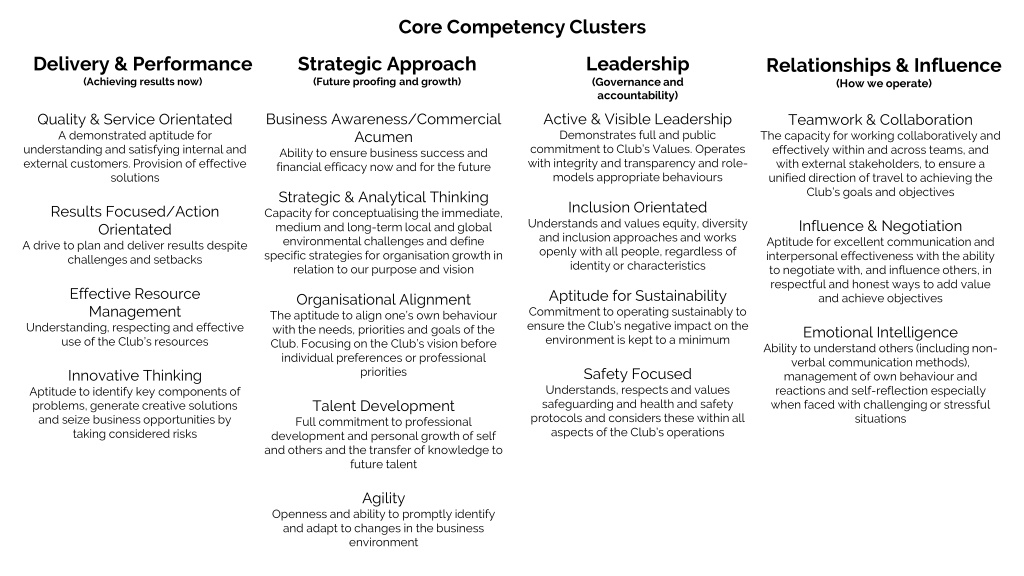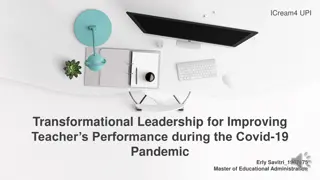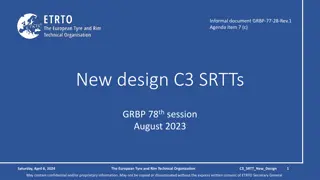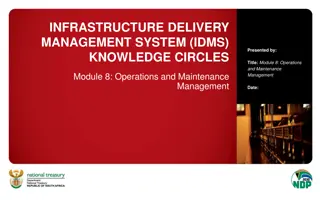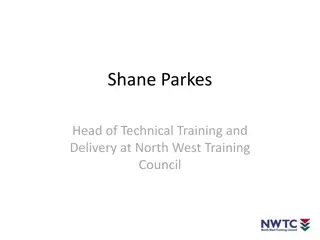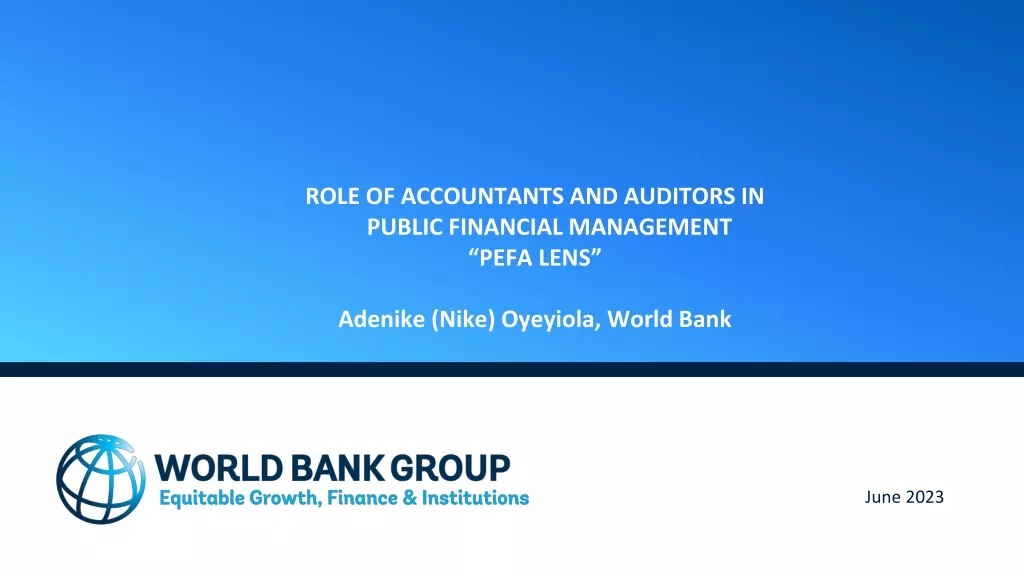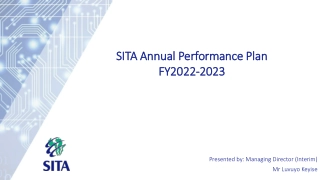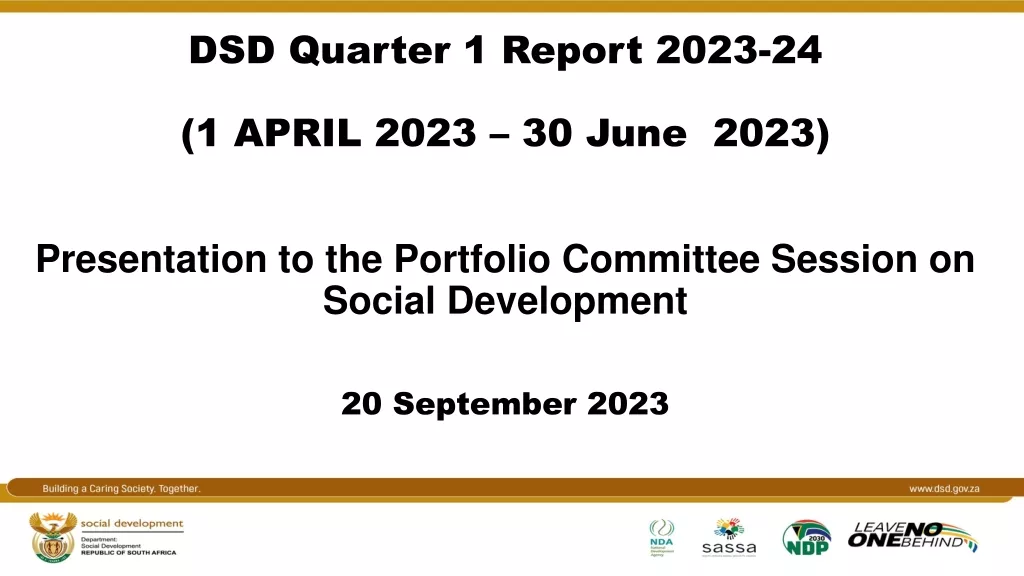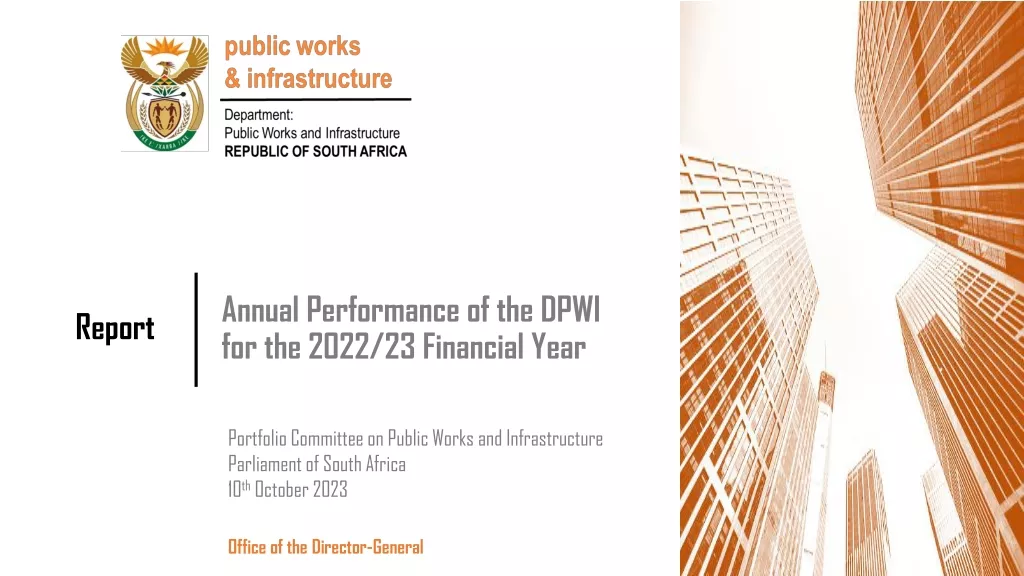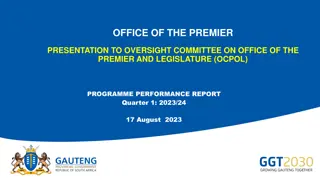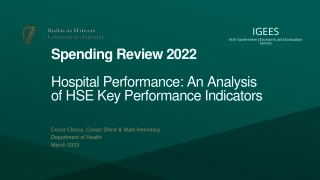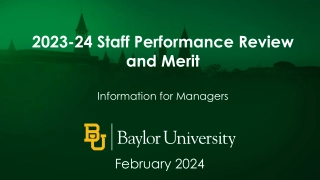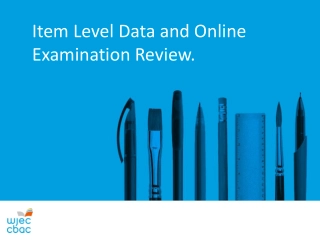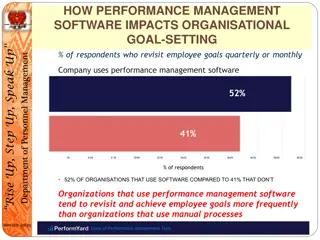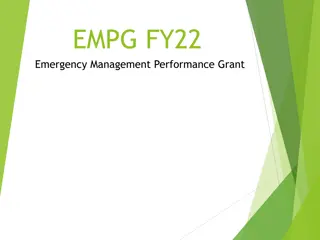Delivery & Performance
Detailed exploration of 16 core competencies essential for organizational success, accompanied by behavior indicators and proficiency levels ranging from Basic to Expert, emphasizing the importance of skill development and alignment with organizational goals.
Download Presentation
Please find below an Image/Link to download the presentation.
The content on the website is provided AS IS for your information and personal use only. It may not be sold, licensed, or shared on other websites without obtaining consent from the author. Download presentation by click this link. If you encounter any issues during the download, it is possible that the publisher has removed the file from their server.
Presentation Transcript
Core Competency Clusters Delivery & Performance (Achieving results now) Strategic Approach (Future proofing and growth) Leadership (Governance and accountability) Relationships & Influence (How we operate) Business Awareness/Commercial Acumen Ability to ensure business success and financial efficacy now and for the future Active & Visible Leadership Demonstrates full and public commitment to Club s Values. Operates with integrity and transparency and role- models appropriate behaviours Quality & Service Orientated A demonstrated aptitude for understanding and satisfying internal and external customers. Provision of effective solutions Teamwork & Collaboration The capacity for working collaboratively and effectively within and across teams, and with external stakeholders, to ensure a unified direction of travel to achieving the Club s goals and objectives Strategic & Analytical Thinking Capacity for conceptualising the immediate, medium and long-term local and global environmental challenges and define specific strategies for organisation growth in relation to our purpose and vision Inclusion Orientated Understands and values equity, diversity and inclusion approaches and works openly with all people, regardless of identity or characteristics Results Focused/Action Orientated A drive to plan and deliver results despite challenges and setbacks Influence & Negotiation Aptitude for excellent communication and interpersonal effectiveness with the ability to negotiate with, and influence others, in respectful and honest ways to add value and achieve objectives Effective Resource Management Understanding, respecting and effective use of the Club s resources Aptitude for Sustainability Commitment to operating sustainably to ensure the Club s negative impact on the environment is kept to a minimum Organisational Alignment The aptitude to align one s own behaviour with the needs, priorities and goals of the Club. Focusing on the Club s vision before individual preferences or professional priorities Emotional Intelligence Ability to understand others (including non- verbal communication methods), management of own behaviour and reactions and self-reflection especially when faced with challenging or stressful situations Safety Focused Understands, respects and values safeguarding and health and safety protocols and considers these within all aspects of the Club s operations Innovative Thinking Aptitude to identify key components of problems, generate creative solutions and seize business opportunities by taking considered risks Talent Development Full commitment to professional development and personal growth of self and others and the transfer of knowledge to future talent Agility Openness and ability to promptly identify and adapt to changes in the business environment
Proficiency Levels Each of the 16 core competencies have behavioural indicators which highlight how people can demonstrate the competency. There are five levels of attainment which reflect the variance in complexity, scope and responsibility across jobs. The guidelines for the levels are below. 1. Basic (typically associated with entry level, junior roles, interns etc.) Displays the drive and commitment to the capabilities mentioned in the definition of the competency May need support in demonstrating the competency 2. Intermediate (typically associated with administration, assistant, coordinator roles) Demonstrates the competency at all times without external help Actions satisfy critical expectations under the competency 3. Proficient (typically associated with first line manager roles) Displays expertise (high effectiveness) in the competency Drives others to exhibit the competency Shows the capacity to manage and monitor the application of the competency in self and others 4. Advanced (typically associated with experienced managers, heads of departments etc.) Creates and facilitates implementation of systems which ensure practice of the competency in teams Coaches and guides individuals and teams in demonstrating the competency 5. Expert (typically associated with senior leadership positions e.g. CEO, directors, leadership group) Creates a culture favourable for practicing the competency across the organisation Includes the drive and capabilities expected under competencies in new strategic initiatives to align those initiatives with the Club s culture and policies
Behavioural Indicators: Delivery & Performance Quality & Service Orientated A demonstrated aptitude for understanding and satisfying internal and external customers. Provision of effective solutions. Level 1 1. 2. 3. 4. Identifies and prioritises customer needs whilst recognising constraints and managing expectations appropriately. Responds to customers in a timely, professional, helpful and courteous manner, regardless of client attitude. Clearly shows customers that their perspectives are valued. Strives to consistently meet quality and service standards. Level 2 1. 2. 3. 4. Follows-up with customers during and after the delivery of services to ensure that their needs have been met. Keeps customers up-to-date on the progress of the service they are receiving and changes that affect them. Seeks to find out more about customers and committed to continually improve service. Establishes and maintains effective professional relationships with customers to gain their trust, respect and loyalty. Level 3 1. 2. 3. 4. Brings together aspects of a trend or policy into a clear picture for others to understand. Looks for ways to add value beyond customers' immediate requests and acts on them. Anticipates customers' upcoming needs and concerns. Explores and addresses long-term customer needs. Level 4 1. Acts as a seasoned adviser, providing independent opinions on complex customer problems and novel initiatives, and assists with handling priority issues. Gives the customer constructive feedback about issues/problems encountered. Advocates on behalf of customers to senior management, identifying approaches that meet the customers' needs as well as those of the organisation. 2. 3. Level 5 1. 2. 3. 4. Builds customer s confidence using own expertise and personal reputation in the community. Knows when it is appropriate to push customers to consider difficult issues and acts accordingly. Determines strategic direction and long-term opportunities to best meet customers' evolving needs. Monitors, evaluates and, as needed, renews the customer service model and service standards.
Behavioural Indicators: Delivery & Performance Results Focused/Action Orientated A drive to plan and deliver results despite challenges and setbacks Level 1 1. Enthusiastically completes tasks and achieves goals within designated timeline 2. Expresses interest to take on additional tasks beyond those already assigned 3. Requests for help proactively in dealing with challenges and obstacles in completing tasks Level 2 1. Sets identifiable and measurable goals and focuses on achieving them 2. Deals effectively with challenges and obstacles arising within the team 3. Plans detailed roadmaps for the task that includes contingency plans Level 3 1. Drives and motivates team members to consistently plan for and achieve goals 2. Displays high level of effectiveness and expertise in consistently achieving goals 3. Helps team members deal with their challenges and setbacks 4. Formulates and implements processes to manage self and team performance 5. Develops capabilities in team members to perform larger and more complex roles Level 4 1. Formulates and implements systems to drive the team to high performance and achievement of goals without stimulus 2. Coaches and guides team members to deal with challenges and consistently strive for higher levels of performance 3. Develops within the team a collective mindset (mental approach) for high performance by consistent emphasis and incentivisation of high performance 4. Uses fewer resources than allocated and devises cost and time saving methods for task execution 5. Contributes to formulation of annual operating strategy for the organisation Level 5 1. Sets high standards of performance for the team and continuously looks at raising the bar 2. Tracks functioning of the organisation through key indicators and reports, to drive performance and to intervene proactively during challenges and setbacks 3. Develops and strengthens a high performance and operational excellence culture across the organisation 4. Formulates and leads the implementation of organisational strategies, plans, policies, practices, systems, and incentives aimed at enhancing organisational performance 5. Incorporates the dimension and aptitudes of high performance in strategic initiatives to align them with the organisation s culture and policies
Behavioural Indicators: Delivery & Performance Effective Resource Management Understanding, respecting and effective use of the Club s resources Level 1 1. 2. Organises the use of resources to meet expectations and identify difficulties. Plans, coordinates and manages internal and external resources to accomplish assignments within the given deadlines. Level 2 1. 2. 3. Manages the allocation of resources in relation to business needs. Manages the work plan, sets timelines and milestones, and involves stakeholders to deliver on time. Provides advice on procedures and the use of financial resources. Level 3 1. 2. 3. Allocates and controls resources within own area of responsibility/ scope of assignment. Identifies needs for resources to effectively support current initiatives, services and offerings. Manages assignments delivery process and deadlines. Level 4 1. Advises and/or develops practical solutions to address resource issues that impact the effectiveness of a team or project and the work to be delivered. Allocates and controls financial resources within own area consistent with goals, priorities and budget. Organises people and activities, separates and combines tasks into an efficient workflow to deliver project outputs according to a clear timeframe. 2. 3. Level 5 1. 2. Sets and redefines priorities and reorganises staff to increase the group s response capacity to internal and external demands. Evaluates the financial impact of decisions and develops strategies to address financial resource issues.
Behavioural Indicators: Delivery & Performance Innovative Thinking Aptitude to identify key components of problems, generate creative solutions and seize business opportunities by taking considered risks. Level 1 1. 2. 3. Implements creative ideas to solve problems at work Looks out for opportunities to apply innovative ideas to improve own performance Applies existing practices or processes to new work situations to benefit the organization and its customers Level 2 1. 2. 3. Consistently adds innovative insights to work practices and processes Develops innovative ideas to deal with challenges at work Takes calculated risk in implementing innovative ideas. Level 3 1. 2. 3. 4. 5. Drives team members to implement innovative ideas and take calculated risks in solving problems or improving performance Consistently proposes and implements highly effective innovative ideas Assists the team in dealing with challenges through innovative thinking Improves systems and structures innovatively to deliver results with more streamlined resources Strengthens creative capabilities and risk taking attitude of team members through special improvement projects Level 4 1. 2. 3. 4. 5. Conceptualises and executes systems that promote innovation and calculated risk taking in the team Coaches and guides team members to promote innovation in their teams Develops a collective mindset in the team favourable for innovation and risk taking through consistent emphasis and positive reinforcement Integrates input and ideas from different sources to explore novel opportunities for improvement in team s and organisation s performance Contributes to organisational strategies on creating an innovative organisation Level 5 1. 2. 3. 4. 5. Consistently implements innovative approaches that others across the organisation use as a reference for innovative behaviour Proactively develops innovative business continuity plans and protocols for dealing with emergencies and calamities Conceptualises and leads implementation of organisational strategies to build an innovative organisation Creates and sustains an innovative culture through innovation supportive policies, goal setting, performance management and rewards Includes innovation and risk taking as critical requirements in strategic initiatives to align the initiatives with the organisation s culture and policies
Behavioural Indicators: Strategic Approach Business Awareness/Commercial Acumen Ability to ensure business success and financial efficacy now and for the future Level 1 1. Shows interest and consideration for revenue and cost implications of own work Level 2 1. Seeks opportunities to further knowledge and understanding of revenue and costs of own and team s work Level 3 1. Drives team members to understand and consider revenue and cost implications of their work 2. Exhibits strong knowledge of and capabilities in business finance, costing, revenue, and profitability 3. Consistently identifies and utilises opportunities to enhance revenue, and financial efficacy (profits, cost/benefit, ROI etc.) within the team 4. Assists team members in dealing with challenges in executing programs and implementing processes aimed at enhancing operational productivity and financial efficacy. 5. Develops the capabilities of team members in business finance and operational productivity Level 4 1. Formulates and implements systems that enable teams to achieve operational efficiency and financial efficacy on their own 2. Coaches individuals and teams to enhance revenue, operational productivity, and financial efficacy 3. Develops a collective mindset within the team favourable for enhancing operational productivity and financial efficacy through consistent reference, consideration and positive reinforcement 4. Conceptualises and implements futuristic and technology enabled methods and processes to enhance business, operational efficiency, and financial efficacy 5. Contributes to conceptualising organisation s strategy on enhancing business and financial results Level 5 1. Consistently displays such strong commercial acumen that prompts others across the organisation to learn and emulate 2. Anticipates possible impacts of emergencies and calamities on organisation s operational productivity and financial results and takes steps to neutralise them 3. Conceptualises and leads organisational strategies to achieve enhanced customer base, revenue, and profits 4. Fosters and institutionalises an organisational culture that values and facilitates enhancement of business and financial efficacy 5. Incorporates the behavioural expectations of this competency in new strategic initiatives so as to align the initiatives with organisation s culture and policies
Behavioural Indicators: Strategic Approach Strategic & Analytical Thinking Capacity for conceptualising the immediate, medium and long-term local and global environmental challenges and define specific strategies for Club growth in relation to our purpose and vision Level 1 1. Demonstrates capability to develop a broad, big-picture view of the Club and its mission and its importance Level 2 1. Identifies new information or data to key decision-makers or stakeholders to support their understanding and decisions. 2. Shows basic understanding of competitive advantage and threats, industry trends, emerging technology, market opportunities and stakeholder focus and how these interplay 3. Demonstrates the ability to link long-range visions and concepts to daily work. Level 3 1. Demonstrates awareness of the impact of own work on aspects of organisational strategy, and the impact of organisational strategy on own work. 2. Integrates the organisation s Strategic Plans into the team s plans 3. Develops the capability of strategic analysis of team members 4. Ensures implementation of the actions mandated by the organisation s Strategy for the team 5. Assists team members in dealing with their challenges in implementing strategic initiatives 6. Displays strong knowledge of Strategic Analysis and Planning Level 4 1. Identifies and considers emerging development opportunities and risks when articulating new options and recommendations 2. Maintains a broad, strategic perspective while identifying and focusing on crucial details 3. Develops and implements systems that enable the implementation of the organisation s Strategy without encouragement 4. Coaches team members in developing key components of the organisational Strategy and other strategic initiatives 5. Develops a collective mindset favourable for implementing the organisation s Strategy through consistent emphasis and positive reinforcement 6. Develops Strategic Planning capabilities among members of the team as part of their career growth 7. Contributes to the formulation of organisation s Strategic Plan Level 5 1. Understands the position of the Club in the larger world context 2. Conveys a thorough understanding of the organisation s strengths, weaknesses, opportunities and threats and identifies competitive differentiators. 3. Considers the bigger picture while setting priorities and the way forward. 4. Consistently displays such strong strategic acumen that prompts others across the organisation to learn from and emulate 5. Leads on the formulation of organisation s Strategic Plan
Behavioural Indicators: Strategic Approach Organisational Alignment The aptitude to align one s own behaviour with the needs, priorities and goals of the Club. Focusing on the Club s vision before individual preferences or professional priorities Level 1 1. 2. Understands the role and goals of the Organisation and how they relate to own area of work Is able to explain how own work relates to the purpose and vision of the Organisation Level 2 1. 2. Understands the Organisation's priorities and how they relate to own area of work Explains and convinces others of the need for adaptation and change of policies, structures, and methods Level 3 1. Stays aware of the organisational objectives and monitors current developments and trends that may affect implementation of organisational plans Helps others understand the strategic goals of the Organisation and how their work relates to these Sets individual and team objectives to align with the organisation s strategic priorities and objectives 2. 3. Level 4 1. Promotes a shared understanding of the Organisation's needs and strategic direction to rally teams Level 5 1. 2. Uses a variety of means to communicate the Organisation s needs and strategic directions Develops a strategic direction for the Club that connects the role of all teams to the success of the Organisation and actively communicates this to all
Behavioural Indicators: Strategic Approach Talent Development Full commitment to professional development and personal growth of self and others and the transfer of knowledge to future talent Level 1 1. Displays active interest in learning new skills 2. Exhibits an understanding of the importance of learning in career progression 3. Seeks help in practicing new skills whenever required 4. Takes advantage of learning opportunities provided (e.g. courses, feedback) to meet requirements of current job 5. Sets clear self-development expectations Level 2 1. Seeks out learning opportunities beyond the requirements of current role 2. Shows awareness of personal shortcomings and works towards overcoming them 3. Proactively looks for and plans to participate in learning events 4. Actively shares knowledge with colleagues 5. Self-assesses against standards for current position to identify learning needs 6. Demonstrates initiative in professional self-development Level 3 1. Urges team members to actively pursue learning and acquire capabilities 2. Recommends readings, training and other resources to develop team members 3. Provides constructive feedback to others 4. Consistently participates in learning programs to expand own skill sets 5. Assists team members in making and implementing their personal and professional development plans 6. Supports and encourages team members to apply new knowledge or skills 7. Develops and implements comprehensive learning and development plans for the team Level 4 1. Creates and implements systems that promote personal and professional development in the team 2. Coaches and guides managers and leaders to promote learning and development in their teams 3. Creates a mindset favourable for continuous learning in the team through consistent emphasis and positive reinforcement 4. Creates opportunities for cross functional learning and professional growth of team members 5. Contributes to organisational strategies on developing a learning friendly organisation 6. Assembles teams with complementary skills and promotes the expectation that they will learn from one another 7. Encourages others to take on new responsibilities in order to support professional development 8. Gives feedback that is constructive and precise based on facts and behavioural patterns observed, and gives individualised suggestions for improvement Level 5 1. Consistently broadens own worldview and capabilities and visibly applies them at work for others across the organisation to learn from and emulate 2. Proactively seeks feedback from customers, peers, and team to improve own, team s and organisation s performance 3. Creates a culture that embeds personal and professional development across the organisation 4. Conceptualises and leads the implementation of organisational strategy to enhance the intellectual capital to create strategic advantage for the organisation 5. Includes the organisation s high emphasis on personal and professional development in new strategic initiatives to ensure their alignment with the organisation s culture and policies 6. Delegates authority and responsibility with the capacity to do a task in one s own way and encourages others to take the lead and learn new skills. 7. Promotes sharing of expertise and supports learning opportunities across the Organisation 8. Develops a common understanding and is transparent about staff potential to take over new responsibilities 9. Encourages others to develop their people through development dialogues and action plans
Behavioural Indicators: Strategic Approach Agility and curious thinking Openness and ability to promptly identify and adapt to changes in the business environment alongside having a curious and flexible approach to drive progress Level 1 1. Has a positive attitude and enthusiastically adapts to ambiguity and organisational changes arising out of unforeseen environmental changes 2. Identifies areas of work that would need to change for performing effectively in changed business situations and implements changes accordingly 3. Proactively seeks help from superiors in dealing with major challenges in business environment 4. Proposes ways to do things differently 5. Understands and recognises the value of other points of view and ways of doing things Level 2 1. Effectively supports with impacts of environment changes on own team 2. Anticipates having to adapt work methods to changing technology and environments 3. Considers problems from all new perspectives and can expand on the thinking or solutions proposed by others 4. Identifies resource constraints that make it difficult to deal with environmental changes and makes suggestions to bridge the gap 5. Adapts to new ideas and initiatives relevant to own area of work 6. Understands and promotes the Organisation s business needs and policies for introducing change Level 3 1. Drives team members to identify environmental and organisational changes and adapt their methods and action plans accordingly 2. Displays consistently high levels of success and effectiveness in identifying and dealing with the impact of environmental changes on the team 3. Assists and supports team members in facing complex challenges arising out of environmental change 4. Consistently monitors, manages and develops the application of this capability within all team members Level 4 1. Conceptualises and facilitates implementation of systems that enables practice of this competency in the organisation without any stimulus 2. Coaches team members to conceptualise, implement and lead change initiatives in their teams in accordance with organisational strategies and environmental changes 3. Develops a collective mindset in the team through continuous emphasis on change preparedness and incentives and to see the positive outcome of doing things differently 4. Implements futuristic technology enabled work practices to develop change readiness and operational flexibility among team members 5. Contributes to organisational strategies on building a flexible/agile organisation Level 5 1. Solves problems arising out of environmental challenges which affect the organisation as a whole 2. Implements latest practices on building an agile organisation in daily practice 3. Develops and leads the implementation of organisation s strategies to deal with changes in business environment 4. Works towards building a culture of change readiness and operational flexibility across the organisation 5. Solicits ideas and responds positively to those of staff and other internal and external stakeholders 6. Includes building an agile organisation as a critical objective in new strategic initiatives
Behavioural Indicators: Leadership Active & Visible Leadership Demonstrates full and public commitment to Club values. Operates with integrity and transparency and role models appropriate behaviours Level 1 1. Abides by the Club s Values and codes of conduct, standing up for what is right and calling out behaviour at any level which does not align 2. Supports managers by remaining consistently focused on tasks and objectives and recognises when others are not Level 2 1. Supports others in taking independent action 2. Resolves issues that occur, with minimal direction 3. Assumes additional responsibilities to facilitate the achievement of team goals 4. Consistently role models appropriate behaviours which align with the Club s Values Level 3 1. 2. 3. 4. 5. 6. Level 4 1. Consistently and visibly complies with Club standards, Values and behaviours and actively encourages team members and colleagues across the organisation to do so 2. Coaches and guides team members to strengthen their leadership abilities 3. Contributes to developing organisation strategies and programs on leadership development 4. Provides clear directions and priorities to teams 5. Organises teamwork to encourage co-operation and bring together complementary skills/expertise 6. Credits individual contributions and acknowledges team accomplishments 7. Facilitates the discussion and resolution of conflicts or disagreement Consistently and visibly complies with Club standards, Values and behaviours and actively encourages team members to do so Drives the energies of team members towards higher performance and acquiring capabilities Delegates tasks and responsibilities to individuals in a way that best utilises their competence and skills, making them accountable for successful execution Works with team members to help them plan their career path Encourages people with opposing viewpoints to express their concerns Resolves conflict among team members sensitively and fairly Level 5 1. Consistently achieves leadership milestones and goals that others across the organisation aspire for 2. Systematically engages with and guides managers occupying or likely to occupy key leadership positions 3. Conceptualises and leads the implementation of organisation s leadership development strategy 4. Fosters a culture favourable for leadership development across the organisation 5. Emphatically considers leadership development as an important agenda in strategic initiatives to adapt the initiatives to organisation s culture and policies 6. Delegates authority to match responsibility, and holds staff accountable 7. Appropriately involves others in decisions and plans that affect them 8. Sees arising conflict and takes action at organisation level
Behavioural Indicators: Leadership Inclusion Orientated Understands and values equity, diversity and inclusion approaches and works openly with all people, regardless of identity or characteristics Level 1 1. 2. 3. 4. Exhibits the aptitude for working inclusively with people of all identities and backgrounds Seeks opportunities for learning and development about equity, diversity and inclusion Actively engages in inclusion initiatives Aptitude for self-reflection, recognising when bias emerges Level 2 1. 2. Supports a working environment which encourages equity, diversity and inclusion Encourages others to be self-reflective and is unafraid to feedback observations of bias or inequity Level 3 1. 2. 3. 4. Encourages and expects team members to adapt to human diversities and work with diverse people Demonstrates high degree of effectiveness in working with diverse people Understands, values and actively participates and promotes inclusion initiatives Holds people to account if they behave in an exclusive manner Level 4 1. Formulates and implements systems that enable team members to exhibit diversity sensitive and inclusive behaviour on their own 2. Coaches and guides team members to ensure diversity friendly, inclusive, and equitable behaviour within the team 3. Develops a collectively inclusive mindset within the team through consistent emphasis and reinforcement of unprejudiced behaviour 4. Contributes to formulation of organisation s diversity, equity, and inclusion strategies Level 5 1. Shows abilities to deal with diversity of people and unfamiliar business situations that become examples for others across the organisation to adopt 2. Proactively prevents diversity unfriendly and prejudiced responses in all situations 3. Conceptualises and leads implementation of organisation s diversity strategy 4. Creates a culture that strengthens organisation s response to diversity and inclusivity 5. Builds the expectations of inclusive behaviour into new strategic initiatives in order to align the initiatives with the organisation s culture and policies
Behavioural Indicators: Leadership Aptitude for Sustainability Commitment to operating sustainably to ensure the Club s negative impact on the environment is kept to a minimum Level 1 1. 2. 3. Shows awareness of the Club s approach to sustainability and buys-in to why it is important Consistently acts in ways which support the Club s sustainability strategy Challenges behaviour which goes against the Club s sustainability approach Level 2 1. 2. 3. 4. Shows awareness of the Club s approach to sustainability and buys-in to why it is important Consistently acts in ways which support the Club s sustainability strategy Challenges behaviour which goes against the Club s sustainability approach Explores ways in which they can expand their sustainable efforts to meet Club targets Level 3 1. 2. 3. 4. Demonstrates strong understanding and commitment to the Club s sustainability strategy Leads by example and consistently role models appropriate behaviours relating to sustainability Calls out behaviour which does not align with the Club s sustainability strategy and suggests alternatives ways of behaving Holds their team members to account if they are operating in ways counter to the Club s sustainability strategy Level 4 1. Has strong awareness of wider sustainability approaches and demonstrates strong commitment to why these are important 2. Embeds relevant areas of the Club s sustainability strategy into their department s work 3. Coaches team members in how to align with the Club s sustainability approach 4. Contributes to the development of the Club s sustainability strategy Level 5 1. Proactively drives engagement with the Club s sustainability strategy across all areas of the Club 2. Creates a culture that strengthens organisation s response to sustainability 3. Builds the expectations of sustainable behaviour into new strategic initiatives in order to align the initiatives with the organisation s culture and policies 4. Takes an active role in the development of sustainable strategies
Behavioural Indicators: Leadership Safety Focused Understands, respects and values safeguarding and health and safety protocols and considers these within all aspects of the Club s operations Level 1 1. Shows awareness of the Club s approach to safeguarding/health and safety, and buys-in to why they are important 2. Consistently acts in ways which are relevant to their roles and support the Club s safeguarding/health and safety strategies 3. Challenges behaviour which goes against the Club s safety approaches Level 2 1. 2. 3. Shows awareness of the Club s approach to safeguarding/health and safety and buys-in to why they are important Consistently acts in ways which are relevant to their roles and support the Club s safeguarding/health and safety strategies Confidently challenges behaviour which goes against the Club s safety approaches Level 3 1. 2. 3. 4. Demonstrates strong understanding and commitment to the Club s safeguarding/health and safety strategies and approaches Leads by example and consistently role models appropriate behaviours relating to safety Calls out behaviour which does not align with the Club s safety strategies and suggests alternatives ways of behaving Holds their team members to account if they are operating in ways counter to the Club s safety strategies Level 4 1. Has strong awareness of wider safeguarding/health and safety approaches and demonstrates strong commitment to why these are important 2. Embeds relevant areas of the Club s strategies into their department s work 3. Coaches team members in how to align with the Club s safety approaches 4. Contributes to the development of the Club s safety strategies Level 5 1. Proactively drives engagement with the Club s safeguarding/health and safety strategies across all areas of the Club 2. Creates a culture that strengthens organisation s response to safety 3. Builds the expectations of safe behaviour into new strategic initiatives in order to align the initiatives with the organisation s culture and policies 4. Takes an active role in the development of safety strategies
Behavioural Indicators: Relationships & Influence Teamwork & Collaboration The capacity for working collaboratively and effectively within and across teams, and with external stakeholders, to ensure a unified direction of travel to achieving the Club s goals and objectives Level 1 1. Works collaboratively with colleagues to complete group tasks 2. Shows flexibility in considering opinions of others 3. Exhibits keenness to achieve consensus in group tasks 4. Initiates collaboration with others and spontaneously assists others in the delivery of their work 5. Shares all relevant information with others and seeks others' input 6. Expresses own opinion while remaining factual and respectful Level 2 1. Displays strong aptitude for collaborating with others in achieving team goals 2. Invites and builds on the ideas of others 3. Proactively seeks inputs from others and listens to them 4. Remains an active team member from start to finish in group tasks Level 3 1. Drives team members to achieve collective goals by collaborating with one another 2. Assumes accountability for work delegated to others (peers, team members, etc.) 3. Shows high level of effectiveness in collaborating with others 4. Seeks to work with teams with complementary skills/expertise. 5. Facilitates exchange of opinion within and across teams 6. Gives credit for success to team members and acknowledges their contributions to team effectiveness 7. Develops capabilities in team members to deal with challenges that affect collaboration Level 4 1. Implements processes and rewards for building team unity among members 2. Coaches and guides members to work in teams more effectively and sets clear expectations 3. Partners with other functions/teams to leverage collective resources for optimal organisational results 4. Develops a collaborative climate within the team through management processes and rewards 5. Contributes to Top Management deliberations on structures, policies and processes that enable collective optimisation of organisation s resources Level 5 1. Shows such collaborative capabilities and aptitudes in working with individuals and teams across all levels that others across the organisation wish to emulate 2. Consistently leads collaborative efforts of diverse teams across the organisation 3. Conceptualises and leads the implementation of organisation strategy, structures, policies, and practices to ensure synergistic functioning of all organisational arms 4. Creates and strengthens a collaborative culture across the organisation through appropriate policies, rituals, events, and rewards 5. Considers in new strategic initiatives the collaborative aptitudes and capabilities expected in the organisation to align the initiatives with the organisation s culture and policies
Behavioural Indicators: Relationships & Influence Communication, Influence & Negotiation Aptitude for excellent communication and interpersonal effectiveness with the ability to negotiate with and influence others in respectful and honest ways to add value and achieve objectives Level 1 1. Communicates clearly, both in verbal and written communication 2. Explains complex content in an easy to understand manner 3. Proactively asks for help in dealing with communication challenges 4. Actively listens and checks own understanding of others' communication (e.g. paraphrases, asks questions). 5. Maintains continuous, open and consistent communication with others 6. Builds on successful initiatives to gain support for ideas 7. Adapts arguments to others' needs/interests 8. Identifies main negotiating points of a given issue and engages in negotiation 9. Listens to differing points of view and promotes mutual understanding Level 2 1. Communicates effectively and assertively across situations 2. Keeps communications focused on objectives and goals and does not allow digression 3. Persuades by using concrete examples to make a point 4. Recalls others' main points and takes them into account in own communication 5. Reads cues from various listeners to assess when and how to change the planned communication approach to effectively deliver messages 6. Identifies main negotiating points of a given issue and leads in negotiation Level 3 1. Encourages team members to communicate effectively 2. Creates opportunities for people to engage in open and transparent communication 3. Identifies communication needs to synchronise collective efforts and creates communication plans accordingly 4. Monitors the content and delivery of important messages by self and team members and intervenes, whenever required, to improve the quality of communication 5. Uses compelling argumentation to convey conclusions and ideas 6. Understands others' complex or underlying needs, motivation, emotions or concerns and adjusts communication effectively 7. Identifies minimal or ideal conditions of others during negotiations 8. Negotiates based on first-hand observations and information collected from both sides avoiding using hearsay or personal opinions Level 4 1. Formulates and implements tools and processes to ensure continuous communication within the team, and between the team and other stakeholders 2. Coaches and guides team members to communicate more effectively 3. Promotes a collective mindset (mental approach) favourable for unhindered communication and exchange of ideas within the team and across the organisation 4. Contributes to organisation s communication strategy and policy formulation 5. Communicates complex issues clearly and credibly with widely varied audiences 6. Scans the environment for key information and messages to form the development of communication strategies 7. Uses situations (e.g. the setting, people present, sequence of events) to create a desired impact and to maximise the chances of a favourable outcome 8. Prepares and effectively runs negotiating meetings to achieve a specific objective 9. Negotiates in a constructive manner when tackling difficult issues 10. Makes realistic compromises during negotiations 11. Maintains an objective, non-emotional distance from interpersonal conflicts or arguments that arise during negotiations
Behavioural Indicators: Relationships & Influence Emotional Intelligence Ability to understand others (including non-verbal communication methods), management of own behaviour and reactions and self-reflection especially when faced with challenging or stressful situations Level 1 1. 2. 3. 4. Listens actively, considers people s concerns and adjusts own behaviour in a helpful manner Understands the reason behind, or motivation for someone s actions Is attentive when doing projects and assignments, or when interacting with people from different cultures and backgrounds Expresses negative feelings constructively Level 2 1. Reflective and self aware within challenging and stressful situations and is able to manage their and others reactions appropriately Level 3 1. 2. 3. 4. Maintains objectivity when one s own positions or opinions are challenged by peers or stakeholders Encourages others to contribute by overcoming cultural barriers and background differences Remains objective when facing criticism Coaches team members in self-reflection and self-awareness Level 4 1. Identifies and responds to underlying attitudes or behaviour patterns such as cultural norms and personality differences 2. Phrases ideas in a way that avoids negative reactions (internally as well as externally) 3. Reacts purposefully to frustrations Level 5 1. Makes one s case tactfully, especially when dealing with the highest level of stakeholder 2. Knows when to stand firm and when to accommodate 3. Accurately hears and understands the unspoken thoughts or feelings of others and acts purposefully
